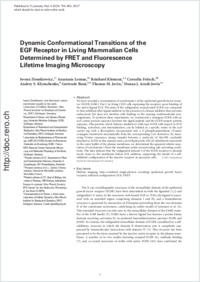Dynamic conformational transitions of the EGF receptor in living mammalian cells determined by FRET and fluorescence lifetime imaging microscopy
- Ziomkiewicz, Iwona Laboratory of Cellular Dynamics, Max Planck Institute for Biophysical Chemistry, Göttingen, Germany - Department of Plant and Environmental Sciences, University of Copenhagen, 1871 Frederiksberg, Denmark
- Loman, Anastasia Department of Neuro and Sensory Physiology, University Medicine Göttingen, Germany - Centre d'Immunologie, Université Marseille-Luminey, Marseille, France
- Klement, Reinhard Laboratory of Cellular Dynamics, Max Planck Institute for Biophysical Chemistry, Göttingen, Germany - Department of Theoretical and Computational Biophysics, Max Planck Institute for Biophysical Chemistry, Göttingen, Germany
- Fritsch, Cornelia Laboratory of Cellular Dynamics, Max Planck Institute for Biophysical Chemistry, Göttingen, Germany - Dept of Biology, University of Fribourg, 1700 Fribourg, Switzerland
- Klymchenko, Andrey S. Laboratoire de Biophotonique et Pharmacologie, Faculté de Pharmacie, Université de Strasbourg, France
- Bunt, Gertrude Department of Neuro and Sensory Physiology, University Medicine Göttingen, Germany - DFG Research Center Nanoscale Microscopy and Molecular Physiology of the Brain, Göttingen, Germany
- Jovin, Thomas M. Laboratory of Cellular Dynamics, Max Planck Institute for Biophysical Chemistry, Göttingen, Germany
- Arndt-Jovin, Donna J. Laboratory of Cellular Dynamics, Max Planck Institute for Biophysical Chemistry, Göttingen, Germany
-
2013
Published in:
- Cytometry Part A. - 2013, vol. 83, no. 9, p. 794–805
lifetime imaging
time-correlated single-photon counting
epidermal growth factor receptor
tethered configuration
EGF
FRET
English
We have revealed a reorientation of ectodomain I of the epidermal growth factor receptor (EGFR; ErbB1; Her1) in living CHO cells expressing the receptor, upon binding of the native ligand EGF. The state of the unliganded, nonactivated EGFR was compared to that exhibited after ligand addition in the presence of a kinase inhibitor that prevents endocytosis but does not interfere with binding or the ensuing conformational rearrangements. To perform these experiments, we constructed a transgene EGFR with an acyl carrier protein sequence between the signal peptide and the EGFR mature protein sequence. This protein, which behaves similarly to wild-type EGFR with respect to EGF binding, activation, and internalization, can be labeled at a specific serine in the acyl carrier tag with a fluorophore incorporated into a 4′-phosphopantetheine (P-pant) conjugate transferred enzymatically from the corresponding CoA derivative. By measuring Förster resonance energy transfer between a molecule of Atto390 covalently attached to EGFR in this manner and a novel lipid probe NR12S distributed exclusively in the outer leaflet of the plasma membrane, we determined the apparent relative separation of ectodomain I from the membrane under nonactivating and activating conditions. The data indicate that the unliganded domain I of the EGFR receptor is situated much closer to the membrane before EGF addition, supporting the model of a self-inhibited configuration of the inactive receptor in quiescent cells.
- Faculty
- Faculté des sciences et de médecine
- Department
- Département de Biologie
- Language
-
- English
- Classification
- Biological sciences
- License
-
License undefined
- Identifiers
-
- RERO DOC 32937
- DOI 10.1002/cyto.a.22311
- Persistent URL
- https://folia.unifr.ch/unifr/documents/303299
Other files
Statistics
Document views: 110
File downloads:
- pdf: 227
- Supplementary material: 157

